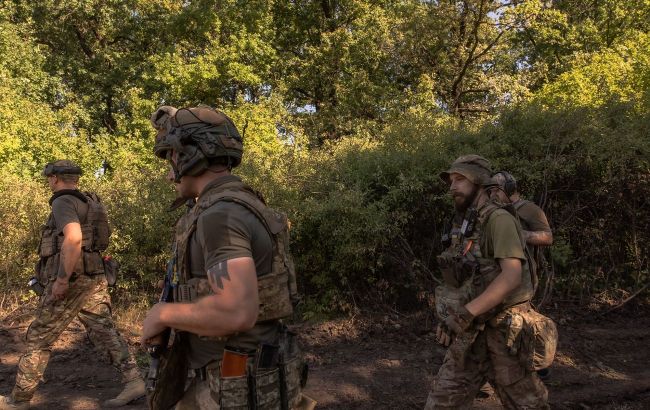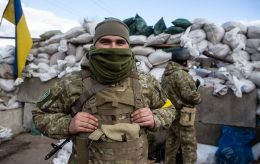How long could Ukrainian Armed Forces hold positions in Kursk region and what it depends on: Expert opinion
 Illustrative photo (Getty Images)
Illustrative photo (Getty Images)
During a recent offensive by the Ukrainian Armed Forces (UAF) in the Kursk region, Russian forces have reportedly lost control of over seventy settlements. The operation is ongoing, but how long the Ukrainians will maintain a military presence on Russian territory depends on the objectives set by their command.
More details on how long the UAF might hold these territories in the Kursk region, and what factors influence this, can be found in the RBC-Ukraine report below.
Contents:
- Factors determining duration of operation in Kursk region
- Russia redeploys troops to defend Kursk, but not from east yet
Factors determining duration of operation in Kursk region
The area of active combat in the Kursk region continues to expand. Ukrainian forces are steadily gaining control over new settlements. As noted by The Washington Post, some analysts are beginning to believe that it may take the Russians at least a year to push the UAF out of the Kursk region.
Forbes writes that Ukrainian forces are digging trenches in the Kursk region, which could indicate that they intend to stay there for a long time.
The author of the article emphasizes that each day the Russian forces fail to counterattack allows the Ukrainians to entrench themselves even further in this region. Thus, the journalists suggest that the stabilization of the front line and a so-called long-term Ukrainian occupation of part of the Kursk region is on the table.
Military expert and retired UAF Major Oleksii Hetman, in a comment to RBC-Ukraine, disagrees with the notion that it might take a year for Russia to reclaim the lost territories in the Kursk region.
"It all depends on what our military leadership has planned. Whether we will hold these positions for long, whether this was a raid, or whether there will be further advancement—answers to these questions are completely classified. Let’s just say, nobody outside a few people in Ukraine's military-political leadership knew there would be a mid-level attack in the Kursk region," Hetman explains.
In his view, the UAF could defend this area just as they do in any other sector of the front.
"But is that the objective of our military leadership? Was there another goal? We can only speculate on what our further plans will be. But the fact that we don’t know much is very good, and let’s keep it that way," Hetman said
Russia redeploys troops to defend Kursk, but not from east yet
Current events in the Kursk region are already forcing the occupiers to redeploy units from the Zaporizhzhia and Kherson regions to contain the UAF, according to Dmytro Lykhoviy, spokesperson for the Tavria Operational Command, who spoke to Politico. He did not specify the exact numbers but noted that they are relatively small. According to the Lithuanian Ministry of Defense, Russia is also redeploying troops to the Kursk region from Kaliningrad.
However, expert Oleksii Hetman notes that the Russians have not yet withdrawn their forces from the eastern directions of Ukraine, where they are making slow but steady advances. But there’s a catch.
"If they do so, it would mean they will stop there. And for them, this is an extremely negative scenario. Will they redeploy troops or not? At least, there is information that those troops that were planned to reinforce the eastern front are now being moved to the Kursk region," Hetman says.
Commander-in-Chief of the UAF, Oleksandr Syrskyi, recently reported that Ukraine controls approximately 1,000 square kilometers of Russian territory. Yesterday, he announced that this area had expanded by an additional 40 square kilometers. According to him, the UAF currently controls 74 Russian settlements.
Meanwhile, the UAF Strategic Communications Directorate has calculated that 1,000 square kilometers of Russian territory is equivalent to around 238 cities the size of Sudzha. The Russian opposition publication Agenstvo (Agency - ed.) writes that this territory can be compared to what Russia has captured since the beginning of the year.
"This is almost twice as much as the territory that the Russians managed to capture during their spring-summer operation, which is now taking place in the east. They managed to capture less territory in that period than what we now have in the Kursk region. So, this is an extremely successful operation," Hetman concluded.
On August 6, it became known about a breach of the border in the Kursk region of Russia from the Sumy region, after which battles began in the area. Almost a week later, President Volodymyr Zelenskyy confirmed Ukraine's involvement in the operation for the first time. He stated that the advance on the territory of the aggressor country continues. As recently emphasized by the Ukrainian Ministry of Foreign Affairs, Kyiv is not interested in seizing Russian territory. Instead, the goal of the UAF operation is to protect Ukrainian lives.
For more details on what is happening in Russia’s border regions, read the RBC-Ukraine report.
We also covered whether the Kursk breakthrough has changed the situation on the front.
Sources: Agenstvo, Politico, Forbes, The Washington Post, statements by UAF Commander-in-Chief Oleksandr Syrskyi, and an exclusive comment from military expert and retired UAF Major Oleksii Hetman.

